AS 201 Prehistory of East Asia
Time Frame:
"Homo erectus" = early human beings; appeared in East Asia over 1,000,000 years ago.
"Homo sapiens" appeared more like 40,000 years ago.
Spread out from Africa and replaced Homo erectus. For the most part.
--Pottery goes back to 10,000 BCE in Japan,
--8,000 BCE in China.
--Bronze age began in China roughly 2,000 BCE
The Neolithic Age in China:
The Yangshao culture in China dates from roughly 5,000 BCE. See also:
1.Peiligang Culture, c. 7000-5000
2.Yangshao Culture, c. 5000-3000
3.Longshan Culture, c. 2700-2000
4.Liangzhu Culture, c. 3500-2000
The Yangshao culture (Chinese: 仰韶文化)

Funerary urn.
Pottery decorated with red and black slip.
Excavated at Panshan, Kansu.
Neolithic culture that existed extensively along the central Yellow River in China. The Yangshao culture is dated from around 5000 BC to 3000 BC. The culture is named after Yangshao, the first excavated representative village of this culture, which was discovered in 1921 in Henan Province. The culture flourished mainly in the provinces of Henan, Shaanxi and Shanxi.
The Yangshao people cultivated millet extensively; some villages also cultivated wheat or rice. They kept such animals as pigs and dogs, as well as sheep, goats, and cattle, but much of their meat came from hunting and fishing. Their stone tools were polished and highly specialized. The Yangshao people may also have practiced an early form of silkworm cultivation.
The Yangshao culture is well-known for its painted pottery. Yangshao artisans created fine white, red, and black painted pottery with human facial, animal, and geometric designs. Unlike the later Longshan culture, the Yangshao culture did not use pottery wheels in pottery-making. Excavations found that children were buried in painted pottery jars.
The Longshan culture (Chinese: 龍山文化)
Longshan culture was noted for its highly polished black pottery (or egg-shell pottery) and is often referred to as the 'Black Pottery Culture' for this reason. Life during the Longshan culture marked a transition to the establishment of cities, as rammed earth walls and moats began to appear, the site at Taosi (陶寺)being its largest walled settlement. Rice cultivation was clearly established by that time. The Neolithic population in China reached its peak during the Longshan culture. Toward the end of the Longshan culture, the population decreased sharply; this was matched by the disappearance of high-quality black pottery found in ritual burials. Early studies indicated that the Longshan and Yangshao cultures were one in the same. It is now widely accepted that the Longshan culture is in fact a later development of the Yangshao (仰韶文化) culture.
So, clearly with Agricultural production, emerging cities, and metallurgy, these cultures were on their way to becoming small city states.
What we might notice, though, is the time frame between the Neolithic (Stone Age, Hunting-Gathering) and the Emergence of "Civilizations" with the Xia and Shang City-State "Dynasties" -- a couple of millenia, 2,000 years, 2500 years? And this is typical of other River Valley civilizations. Japan, though, may have been unique with its Neolithic Period extending for more than 10,000-12,000 years as opposed to anywhere between 2-3,000 or possibly even 4,000 years at the longest.
--700 BCE Age in Korea; Iron 400 BCE
--In Japan Bronze and Iron come in about the same time, probably from Korean Peninsula about 300 BCE?
Why are these things important? Relates to when early states or polities began to take shape.
China from 2,000 BCE, Xia and Shang "Dynasties" --Bronze, Iron,
--Walled Cities, major capitals
--Written Language = 5,000 characters, Logographs = each word = one character
--found on oralcle bones = divination practices
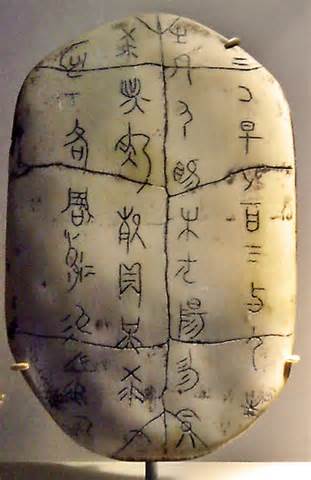
Oracle bones are usually scapula of large animals or turtle shells, that were used by kings and diviners to answer questions and tell the future. A diviner would carve the question into one side, then small pits would be carved out of the other side. They would use the art of pyromancy (using fire) to tell the fortune, or divine the answer from the bone or shell. A red-hot poker would be pressed into the pits, causing the bone or shell to crack. It is these resulting cracks that the diviner would interpret, and the answer was then carved into the oracle bone as well. An interesting point here is that all of the writings for the Shang Dynasty are religious text, since they are all dealing with oracle bones and bronze inscriptions.
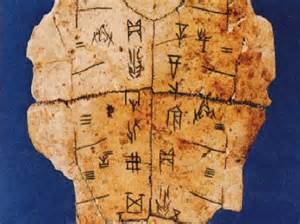
--Rulers = Kings + High Priests
-- walled cities,
--metalworking
--large tombs for ruling families
--burial goods
Zhou Dynasty 1045-256 BCE
-- 100 Schools of Thought
--Ancient "Philosophical" works appear: The Six Books, Confucius (551-479 BCE), the Laozi and Daoism, etc.
Consider also: the three great Greek philosophers, Socrates (469–399 B.C.E.), Plato (429–347 B.C.E.), and Aristotle (384–322 B.C.E) all came shortly after Confucius' time while the Buddha was born in India perhaps around 563 B.C.E.. This means that within a period of century and a half or so, some of the world's most important thinkers appeared. It also means that it is possible that some of the Greek philosophers might have heard either directly or indirectly something of the Buddha's teachings. i.e., the "illusion" that the world we apprehend through our senses is the only or the "real" world. Certainly Plato's allegory of people who are like prisoners chained up inside a cave only witnessing the "shadows" when things pass behind them but in front of a fire which casts their shadow on the cave wall, seems to incorporate a similar line of reasoning.
Images
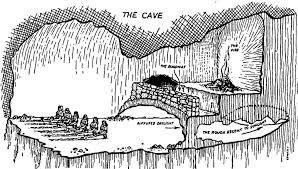
- Unable to turn their heads, all they can see is the wall of the cave. Behind them burns a fire. Between the fire and the prisoners there is a parapet, along which puppeteers can walk. The puppeteers, who are behind the prisoners, hold up puppets that cast shadows on the wall of the cave. The prisoners are unable to see these puppets, the real objects, that pass behind them. What the prisoners see and hear are shadows and echoes cast by objects that they do not see. Here is an illustration of Plato’s Cave:
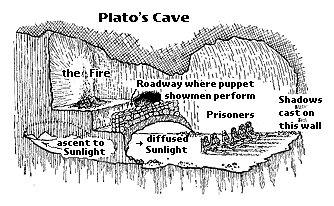
From Great Dialogues of Plato (Warmington and Rouse, eds.) New York, Signet Classics: 1999. p. 316. - Such prisoners would mistake appearance for reality. They would think the things they see on the wall (the shadows) were real; they would know nothing of the real causes of the shadows.
Qin-Han Bureaucratic Empire 256 BCE-200 CE
China has its first sweeping, powerful centralized bureaucratic state in the
Han Dynasty 206 BCE - 220 CE
--Extensive use of written records, histories--Sima Qian (145-56 BCE)
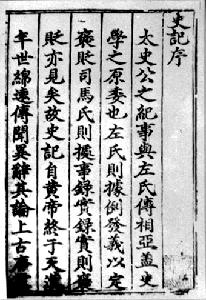
--Centralized adminstrative structure, powerful monarchs and armies, etc.
--Confucian Teachings adopted as key for education, official ranks
--Dynastic Histories
Korea and Japan all this comes much later:
--400-500 CE; at least 600-700 years
--Japan's first major capital city = Nara 710 CE
--First major written works, 700s CE
-- So, really, a millenium or 1500 years later than in China!
--And when they do come into literacy, it is in Chinese, a borrowed language, one that did not even fit the Japanese spoken language very well.
Instructions